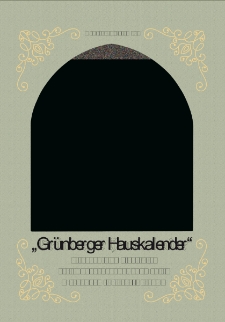Zielonogórska Biblioteka Cyfrowa udostępnia 65 391 obiektów cyfrowych
Obiekt
Tytuł: Grünberger Hauskalender
Podtytuł:
Literackie zwierciadło zielonogórsko-kożuchowskiej mikroprowincji (1910-1940)
Streszczenie:
W pierwszej połowie XX wieku kalendarze książkowe były rozpowszechnione wśród wszystkich grup społecznych. Dzięki swemu uniwersalizmowi i spełnianiu funkcji zarówno informacyjno-literackiego almanachu, jak i klasycznego kalendarium znalazły zastosowanie jako różnego rodzaju poradniki, stanowiły źródło rozrywki i wiedzy, a dzięki łatwej dostępności i masowej dystrybucji miały wpływ na kulturalną i społeczną świadomość. ; Wydawany w latach 1910-1940 "Grünberger Hauskalender" stanowił rodzaj zwierciadła życia społeczno--kulturalnego dla określonego terytorialnie i kulturowo obszaru na Dolnym Śląsku, jakim były powiaty zielonogórski (Kreis Grünberg) i kożuchowski (Kreis Freystadt). Jednocześnie pełnił on rolę literackiego i informacyjnego medium a jako tzw. kalendarz ojczyźniany afirmował "Heimat" - małą ojczyznę, nadając jej rangę wyróżnika lokalnej wspólnoty. ; Niniejsza książka próbuje odpowiedzieć na pytanie, w jakim stopniu "Grünberger Hauskalender" jako organ literacki potrafił oddać tożsamość przestrzeni, w której został powołany do życia i ukazać panoramę kultury niemieckojęzycznych mieszkańców zielonogórsko-kożuchowskiego regionu. I odwrotnie: jak wyglądał wpływ kulturowej przestrzeni na specyfikę powstającej w jej obrębie literatury, jak został nakreślony obraz zielonogórsko-kożuchowskiej mikroprowincji, jakie regionalne motywy i toposy pojawiały się w publikowanych w kalendarzu tekstach literackich.
Abstract:
In the first half of the 20th century, book calendars were widespread among all social groups. Thanks to their universality and fulfilment of the functions of both an informational and literary almanac and a classic calendar, they found their use as various types of guides, became a source of entertainment and knowledge, and, thanks to their easy availability and mass distribution, they had an impact on cultural and social consciousness. ; "Grünberger Hauskalender", which was published between 1910 and 1940, the was like a form of a mirror of socio-cultural life for the territorially and culturally defined areas in Lower Silesia, which were the districts of Zielona Góra (Kreis Grünberg) and Kożuchów (Kreis Freystadt). At the same time, it served as a literary and informational medium and, as a so-called "homeland calendar", affirmed the "Heimat" - the small homeland, giving it the status of a distinctive feature of the local community. ; This book attempts to answer the question to what extent the "Grünberger Hauskalender", as a literary organ, was able to reflect the identity of the area in which it was established and show the panorama of the culture of the German-speaking inhabitants of the Zielona Góra - Kożuchów region. And vice versa: the book explores what was the influence of the cultural area on the character of the literature created within it, how was the picture of the Zielona Góra-Kożuchów microprovince outlined, what regional motifs and topoi appeared in the literary texts published in the calendar.
Wydawca:
Zielona Góra: Oficyna Wydawnicza Uniwersytetu Zielonogórskiego
Format:
Identyfikator zasobu:
DOI:
Jezyk:
Prawa do dysponowania publikacją:
Biblioteka Uniwersytetu Zielonogórskiego
Kolekcje, do których przypisany jest obiekt:
- Zielonogórska Biblioteka Cyfrowa > Repozytorium > Jednostki organizacyjne > Wydział Humanistyczny
- Zielonogórska Biblioteka Cyfrowa > Repozytorium > Typy utworów > Książki
Data ostatniej modyfikacji:
29 maj 2024
Data dodania obiektu:
28 maj 2024
Liczba wyświetleń treści obiektu:
634
Wszystkie dostępne wersje tego obiektu:
https://zbc.uz.zgora.pl/publication/89093
Wyświetl opis w formacie RDF:
Wyświetl opis w formacie OAI-PMH:
| Nazwa wydania | Data |
|---|---|
| Grünberger Hauskalender | 29 maj 2024 |
Obiekty Podobne
Böhm Glaeser, Edmund Klose, Martin Bronisch, P. Petras, Paul Tschierschke, P. Gruhl, Kurt Helm, Otto Hoffmann, Pablo Budenauer, R. H. Heinzel, Max Müller, A. Rössler, Robert Otto, Bruno Lindner Bauer

